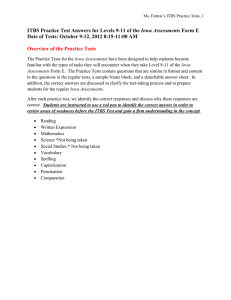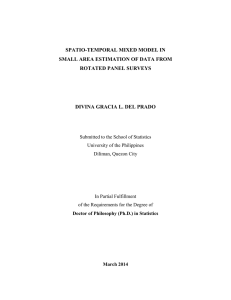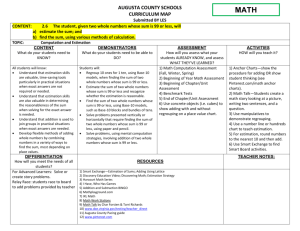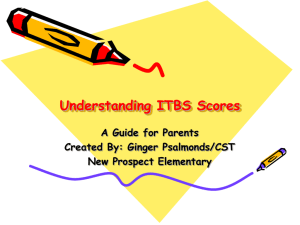Iowa Tests of Basic Skills® (ITBS®) Authors: H.D. Hoover, S.B.
advertisement
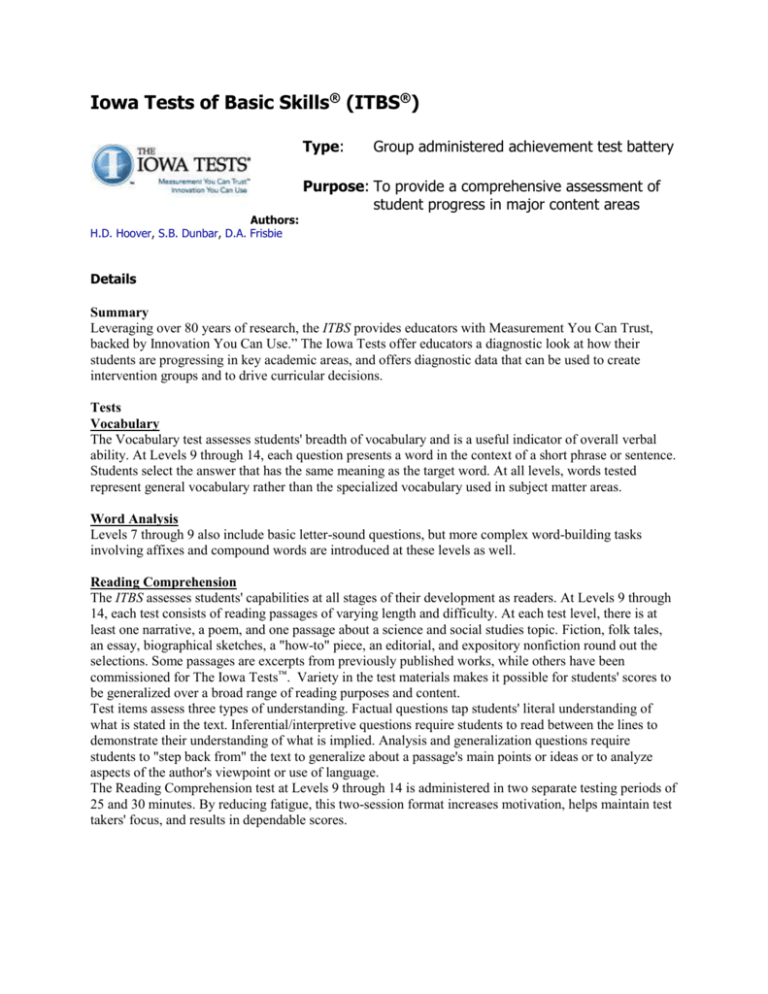
Iowa Tests of Basic Skills® (ITBS®) Type: Authors: H.D. Hoover, S.B. Dunbar, D.A. Frisbie Group administered achievement test battery Purpose: To provide a comprehensive assessment of student progress in major content areas Details Summary Leveraging over 80 years of research, the ITBS provides educators with Measurement You Can Trust, backed by Innovation You Can Use.” The Iowa Tests offer educators a diagnostic look at how their students are progressing in key academic areas, and offers diagnostic data that can be used to create intervention groups and to drive curricular decisions. Tests Vocabulary The Vocabulary test assesses students' breadth of vocabulary and is a useful indicator of overall verbal ability. At Levels 9 through 14, each question presents a word in the context of a short phrase or sentence. Students select the answer that has the same meaning as the target word. At all levels, words tested represent general vocabulary rather than the specialized vocabulary used in subject matter areas. Word Analysis Levels 7 through 9 also include basic letter-sound questions, but more complex word-building tasks involving affixes and compound words are introduced at these levels as well. Reading Comprehension The ITBS assesses students' capabilities at all stages of their development as readers. At Levels 9 through 14, each test consists of reading passages of varying length and difficulty. At each test level, there is at least one narrative, a poem, and one passage about a science and social studies topic. Fiction, folk tales, an essay, biographical sketches, a "how-to" piece, an editorial, and expository nonfiction round out the selections. Some passages are excerpts from previously published works, while others have been commissioned for The Iowa Tests™. Variety in the test materials makes it possible for students' scores to be generalized over a broad range of reading purposes and content. Test items assess three types of understanding. Factual questions tap students' literal understanding of what is stated in the text. Inferential/interpretive questions require students to read between the lines to demonstrate their understanding of what is implied. Analysis and generalization questions require students to "step back from" the text to generalize about a passage's main points or ideas or to analyze aspects of the author's viewpoint or use of language. The Reading Comprehension test at Levels 9 through 14 is administered in two separate testing periods of 25 and 30 minutes. By reducing fatigue, this two-session format increases motivation, helps maintain test takers' focus, and results in dependable scores. Language The Language tests at Levels 9 through 14 measure students' skill in using the conventions of standard written English. The tests constitute a thorough sampling of skills in spelling, capitalization, punctuation, usage, and written expression. Separate scores are reported in each area, and detailed diagnostic reports of strengths and needs are possible because of the content coverage afforded by separate tests. At Levels 9 through 14, the Spelling questions offer four words, one of which may be misspelled, and a fifth "No Mistakes" option. The Capitalization, Punctuation, and Usage and Expression tests present brief written contexts, asking students to identify which line, if any, contains an error. In the Usage and Expression test, students also read stories and are asked to choose the most effective way to express ideas, organize paragraphs, or write an opening, transitional, or concluding sentence or paragraph. Math In accordance with the Curriculum and Evaluation Standards for School Mathematics of the National Council of Teachers of Mathematics (NCTM), the Math tests at all levels do much more than assess skill in solving numerical problems. The tests emphasize the ability to do quantitative reasoning and to think mathematically in a wide variety of contexts. At Levels 7 through 14, there are three separate tests. The first is called Math Concepts at Levels 7 and 8 and Math Concepts and Estimation at Levels 9 through 14. This test requires students to demonstrate their understanding of fundamental ideas in the areas of number properties and operations, geometry, measurement, algebra, probability and statistics, and estimation. At Levels 9 through 14, the separately timed Estimation section tests mental arithmetic, number sense, and various estimation skills such as rounding. The second test, called Math Problems at Levels 7 and 8 and Problem Solving and Data Interpretation at Levels 9 through 14, includes word problems that require one or more steps to solve. In many cases, students select an appropriate method or approach, rather than compute an answer. At Levels 9 through 14, several real-world "stories" form the basis for sets of three to four problems, each requiring somewhat different skills to solve. Levels 7 through 14 also include data displays such as tables and graphs. Students use them to obtain information, compare quantities, and determine trends or relationships. Each problem in the third test, Math Computation, requires one arithmetic operation — addition, subtraction, multiplication, or division. The problems require operations with whole numbers, fractions, decimals, and various combinations of these, depending on the test level. Students must work a problem and compare their answer with the choices given. The last answer option is "N," meaning the correct answer is "Not given." At Levels 9 through 14, calculators may be used on the Concepts portion of the Concepts and Estimation test and on the Problem Solving and Data Interpretation test.
